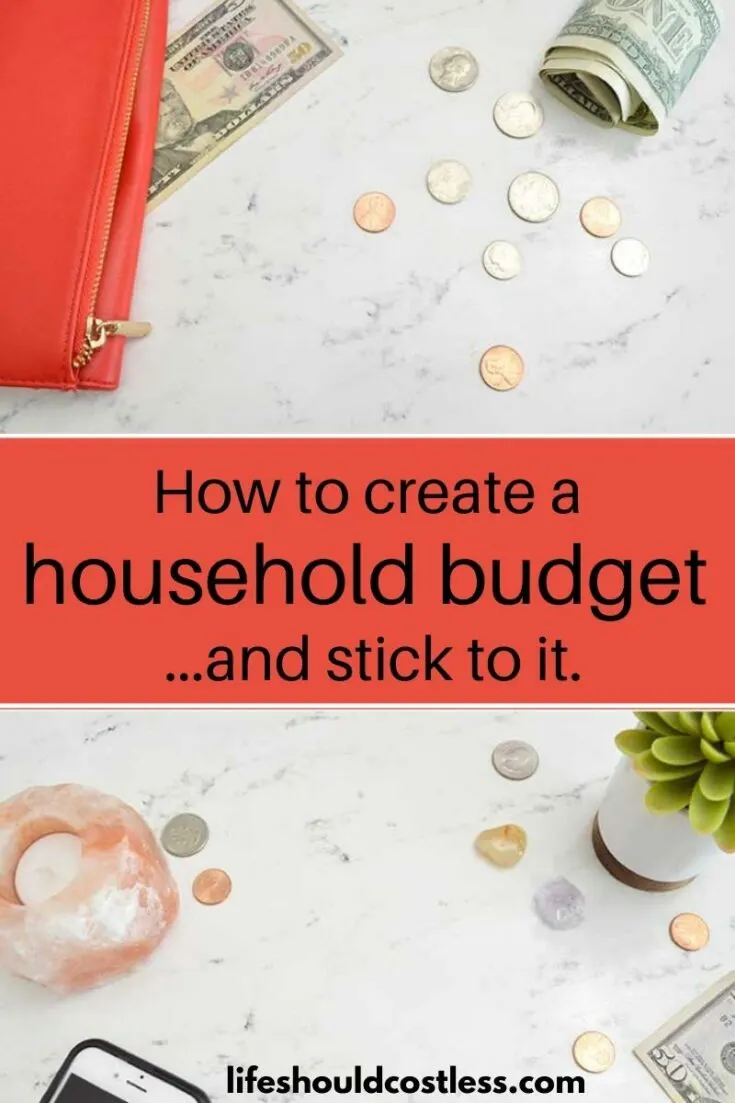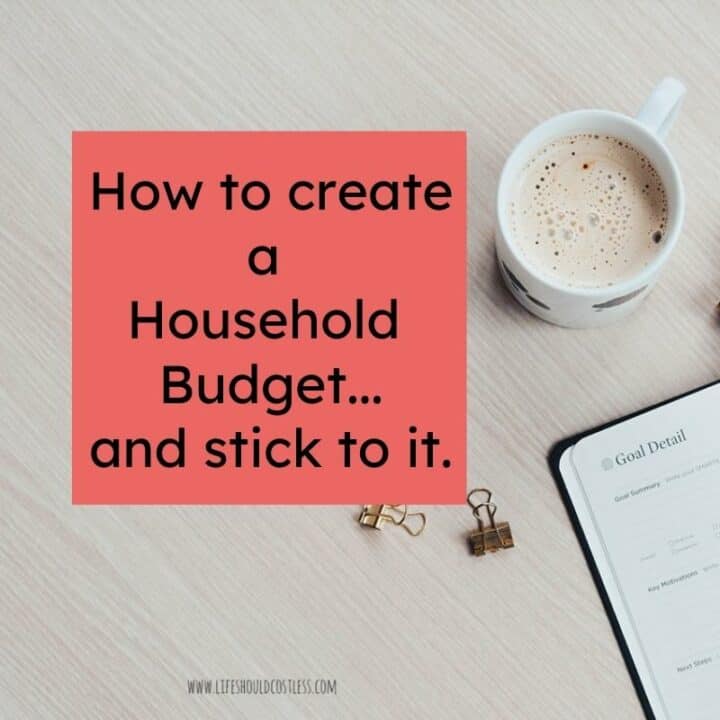Budgeting is one of the best things you can do in order to stay on track financially. Although finding the time to create a budget, and learning how to stick to it, is hard when you’re a busy parent. If you want to get control of your finances, but are struggling to stick to your budget, I am here to tell you that you are not alone. Which is why I want to teach you some helpful tips on how to create a household budget and actually be able to stick to it.

Struggling to stick to a budget?
Busy adults everywhere are struggling with the same financial issue. Learning how to stick to a budget takes a little bit of time, effort, and self control, but I promise you, taking the time to develop budgeting as a life-skill is more than worth it in the end.
Why is it important to stick to a budget?
There are so many great reasons to start budgeting:
- To save for the future
- To get your family out of debt
- To reach a financial goal (or many of them)
- To take a dream vacation
Whatever your reason for wanting or needing to live a frugal lifestyle, make it your own. The reasons you choose to stick to a budget are the things that will motivate you whenever the going gets tough. As you sit down to put your family’s household budget in place, take a few minutes to write down your reasons for budgeting.
Put that list in a prominent place so you can get a reminder from time to time.
These goals can provide great motivation when you’re finding it hard to stay on track with your busy schedule or life in general.
How to make a budget?
I have actually written many posts on the subject already, and rather than rehash it all now, here is a link to my budgeting section so that you can read up on the basics and figure out exactly how you want to tackle creating your own personal budget.
If you’re not a fan of my suggestions, here is another great resource that will get you started on creating your budget.
How to Stick to a Budget
Everyone has their opinions on the best ways to make a budget and stick to it, but not all of those tips will work for everyone.
As a fellow busy adult and a single mom, I’ve found these tips to be the best ways for me to stick to my budget. If you’re wondering how to stick to a budget as a busy parent, here are some of my favorite budgeting tricks:
Make a Realistic Budget
One of the biggest mistakes I see many people making is creating a budget that is unrealistic for their household. While we would all love to instantly slash our grocery bill in half our cut out an extra $1,000 from our monthly spending, those goals just aren’t very attainable when you’re first starting out.
Plus, if you find yourself struggling to stick to your budget every month because you’ve set unreachable goals for yourself, you’re more likely to give up budgeting altogether.
When you’re making your budget, consider small goals you can set for yourself each month that will allow you to reach bigger goals down the road. Instead of trying to cut your grocery bill in half, consider reducing your spending by $10-20 each month until you reach a more reasonable spending goal, for example.
The key is to not make it so hard that you are setting yourself up for failure.
Always have a budgeting plan
Budgeting is all about planning. While taking the time to plan your budget for the month is a big part of budgeting, the small plans you make along the way are how to really stick to a budget. Wondering what other plans you should make throughout the month to help you stick to your budget?
Consider these:
- Meal planning. Planning out all your family’s meals each day of the week is a great way to save money on groceries. In addition to helping you know exactly what you need to buy when you go shopping, a meal plan will also help prevent impulse purchases, like ordering a pizza or dinner at a restaurant, because you didn’t have a plan for dinner in place.
- Grocery lists. Making a shopping list before you head to the grocery store is one of the best ways to rein in your spending. Every time you head to the grocery store, make a list of exactly what you need to buy. Then avoid straying from that list to stay on budget as you shop.
Set a Weekly Budget
Sometimes it’s hard to stretch your budget to the end of the month. However, creating smaller weekly budgets can help you spread your spending a little more evenly.
Grocery purchases and personal spending are both great categories to break down into weekly budgets. Instead of allotting yourself $800 for groceries each month, allow yourself $200 per week for groceries to keep from shorting yourself at the end of every month…basically just spread it out a little bit so that you aren’t living on ramen at the end of each month…lol.
Make Your Budget Adaptable
A budget should never be set in stone. At the end of each month, take the time to look through your budget and the purchases you made. Then, adjust your budget accordingly.
If you constantly find yourself overspending in one area, raise your spending limit in that category. Just make sure you balance your budget by deducting that increase from a category where you underspend.
Pay with Cash
Paying with the swipe of a card is so simple. Though that quick payment makes budgeting a little bit more complicated. Each time you pay with a debit or credit card, you need to keep track of that payment and deduct it from your total spending allotment for the month.
However, by divvying up your monthly spending into cash categories, you can quickly glance at your available cash to know how much you have left to spend in each category.
Also, keep in mind that when using credit cards for everything it is very easy to overspend, so if you’re using one, at the very least make sure that it’s earning good rewards/points and you are paying it off each month.
Criticize Every Purchase
Learning how to stick to a budget means you’ll need to train yourself to think critically about every purchase you make. Before you buy anything that isn’t a necessary purchase, ask yourself if you really need that item.
Avoid impulse purchases by giving yourself the night to think about the purchase and the ways you can avoid spending the extra money. If you can rationally justify buying the item, head back to the store the next day to pay for it, or even take it one step further and shop around online to find the best deal for that item.
Find Small Ways to Save
It can be difficult to save a big chunk of money each month, but it’s easy to find small ways to save a few dollars throughout the month. Those little savings start adding up after a while!
If you’re struggling to find small ways to save money, try:
- Using less water by turning your faucets off when you’re brushing your teeth or washing your hands.
- Make sure all lights are off when you’re not in a room.
- Adjust the power settings on your electronics so they don’t drain power when they’re not in use.
- Reuse as much as you can before throwing it away.
- Shop your pantry for dinner instead of buying food from the grocery store.
- Call your cable, cell phone, and insurance providers and negotiate a new plan…or switch providers altogether to get a better rate.
- Borrow books and movies from your library instead of purchasing new ones.
- Say no to outings that cost money if you don’t have any left in your budget.
- Cut the cable and use a cheaper streaming service instead…or just try to limit yourself to one or two streaming services instead of having all of them.
- Make your own lunch instead of eating out.
- Make your own coffee instead of purchasing it on your way to work.
- Drink water instead of soda, or at least limit yourself to how many refills/cans you drink daily.
- Once you have these habits down, train your family to do them too.
Automatically Pay Your Savings
Paying yourself first is the best way to increase your savings, but it’s hard to budget savings when you’re still learning how to stick to a budget.
Instead of setting aside money for your savings at the end of the month, set up an auto-draft from your checking to your savings the same time your paycheck goes into your checking account.
With an auto-draft, the money will move from your account before you even have a chance to spend it, making it easier to set aside funds for savings or an emergency fund.
Go one further step and make sure that this savings money does not get touched unless there is a true emergency. Some banks/financial institutions allow you to set up an account in a way so that both people on the account must be present to withdraw anything and that is a good fail-safe to have in place if you, or a partner, struggle with self-control in spending.
That’s really all the tips I have to share with you all today to stick to a budget, so hopefully I got you thinking about ways to improve your situation so that you can someday have the financial freedom that you have always wanted.
Thanks so much for stopping by my blog and supporting my endeavors to make people’s lives a little easier/better/more affordable. If you liked this post, or found it helpful in any way, please make sure to share it with your family, friends, and co-workers via social media…or you could even send them the direct link via email. Whichever way you choose to spread the love, I super appreciate it! ~Sarah

How to follow & support this site
- If you would like to subscribe to my email list, go here.
- Make sure to follow along via social media, by going here.
- If you would like to learn how to really show your support to this site (at no cost to you), go here.
- If you would like to make a direct donation to the site, go here.
Here are links to several of my other budgeting posts that you’re also going to like:
*Please note that this post was originally published to this website on February 6, 2020 and has since been updated to improve user experience, as well as to be as up to date and shareable on the social medias as possible.
